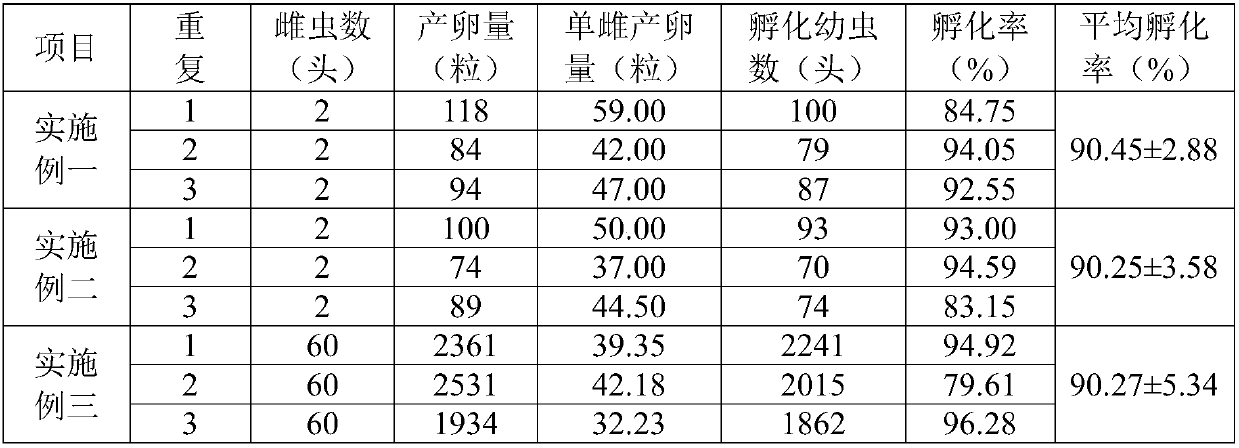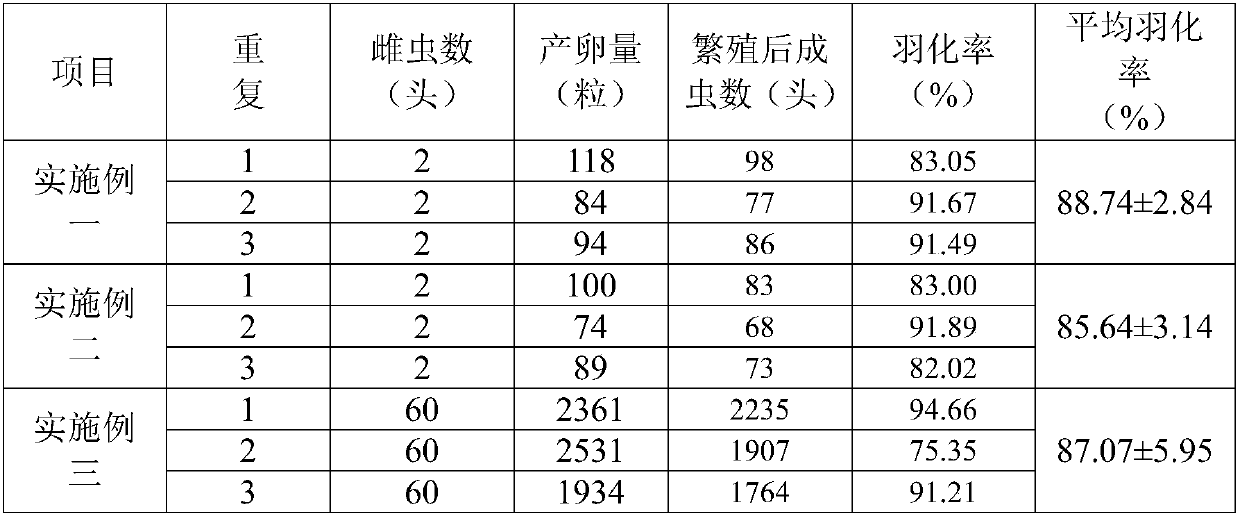Indoor breeding method for adoxophyes braconid
A technology of the brown scalloped wasps and parasitic wasps, which can be applied in the fields of application, animal feed, animal feed, etc., and can solve problems such as obstacles to the use of the insects
- Summary
- Abstract
- Description
- Claims
- Application Information
AI Technical Summary
Problems solved by technology
Method used
Image
Examples
Embodiment 1
[0016] Place 1 senior larvae of S. mellonella in a ventilated 2ml centrifuge tube, and insert 2 newly emerged female adults and 1 male adult of Braconidus moth. Placed in a 25°C incubator. Observe the oviposition of parasitic wasps. After the parasitic wasps are covered with parasitic wasp eggs, the parasitic wasps are taken out and re-inoculated into a centrifuge tube containing an advanced larva of the wax moth. Repeat this step until the female parasitic wasps The bees died, repeated three times, and counted the number of eggs laid. The results are shown in Table 1. The host whose body surface was covered with parasitoid eggs was collected, placed in an incubator for further cultivation, the parasitoid eggs hatched into larvae, the number of larvae was counted, and the hatching rate was calculated. The results are shown in Table 1. After the larvae make cocoons and pupate, collect the bee pupae and store them in an incubator at 10°C.
[0017] The preserved bee pupae were ...
Embodiment 2
[0019] Put 1 prepupa of Orythia spp. into a ventilated 2ml centrifuge tube, and insert 2 newly emerged female adults and 1 male adult of the newly emerged Twister moth. Placed in a 25°C incubator. Observe the oviposition of the parasitic wasps. After the body of the red-veined ear borer is covered with the eggs of the parasitic wasps, take out the parasitic wasps and re-inoculate them in a centrifuge tube with a prepupa of the wax moth moth. Repeat this step until the parasitic wasps The female bees died, repeated three times, and counted the number of eggs laid. The results are shown in Table 1. The host whose body surface was covered with parasitoid eggs was collected, placed in an incubator for further cultivation, the parasitoid eggs hatched into larvae, the number of larvae was counted, and the hatching rate was calculated. The results are shown in Table 1. After the larvae make cocoons and pupate, collect the bee pupae and store them in an incubator at 12°C.
[0020] T...
Embodiment 3
[0022] Place 30 ear borers in a 15 × 10 × 5 cm insect-raising box, the top of which is open and covered with 200-mesh nylon gauze. Inoculate 60 female adults and 30 male adults of Braconis spondyloides into the insect rearing boxes. Placed in a 25°C incubator. Observe the oviposition situation of the parasitic wasps, when most (not less than 70% of the total insect population) of the parasitic wasps are all over the parasitic wasp eggs, the parasitic wasps are taken out and re-inoculated in the insect culture box containing 30 red veined ear borers After that, repeat this step until the parasitoid female wasps die, repeat three times, count the number of eggs laid, and the results are shown in Table 1. The host whose body surface was covered with parasitoid eggs was collected, placed in an incubator for further cultivation, the parasitoid eggs hatched into larvae, the number of larvae was counted, and the hatching rate was calculated. The results are shown in Table 1. After ...
PUM
| Property | Measurement | Unit |
|---|---|---|
| Air hole diameter | aaaaa | aaaaa |
Abstract
Description
Claims
Application Information
 Login to View More
Login to View More - R&D
- Intellectual Property
- Life Sciences
- Materials
- Tech Scout
- Unparalleled Data Quality
- Higher Quality Content
- 60% Fewer Hallucinations
Browse by: Latest US Patents, China's latest patents, Technical Efficacy Thesaurus, Application Domain, Technology Topic, Popular Technical Reports.
© 2025 PatSnap. All rights reserved.Legal|Privacy policy|Modern Slavery Act Transparency Statement|Sitemap|About US| Contact US: help@patsnap.com


